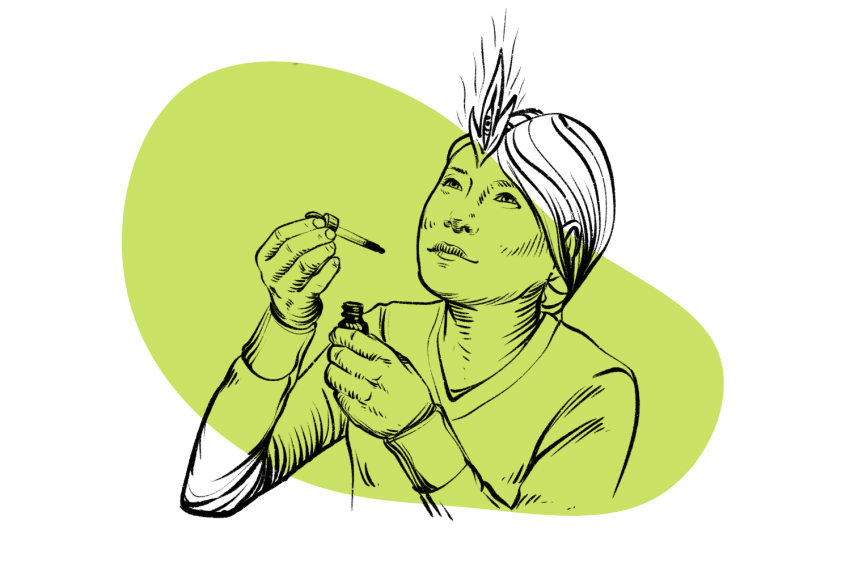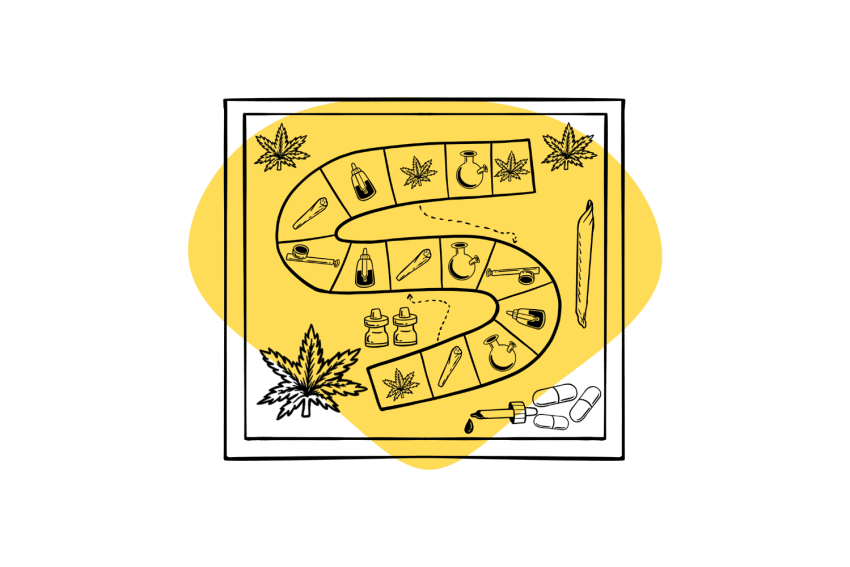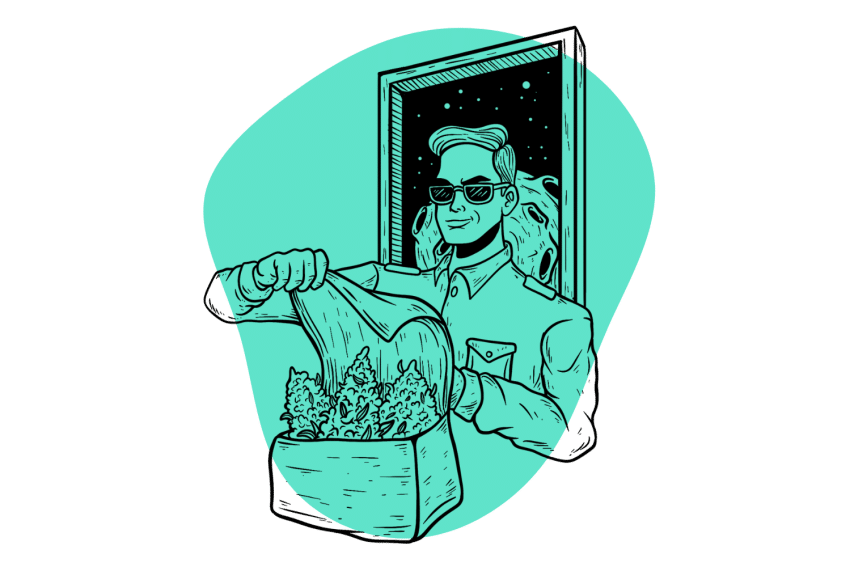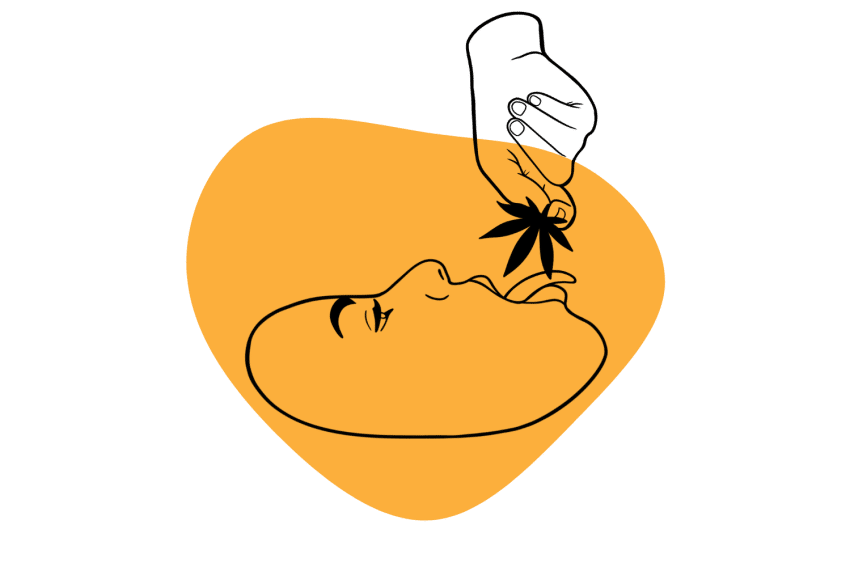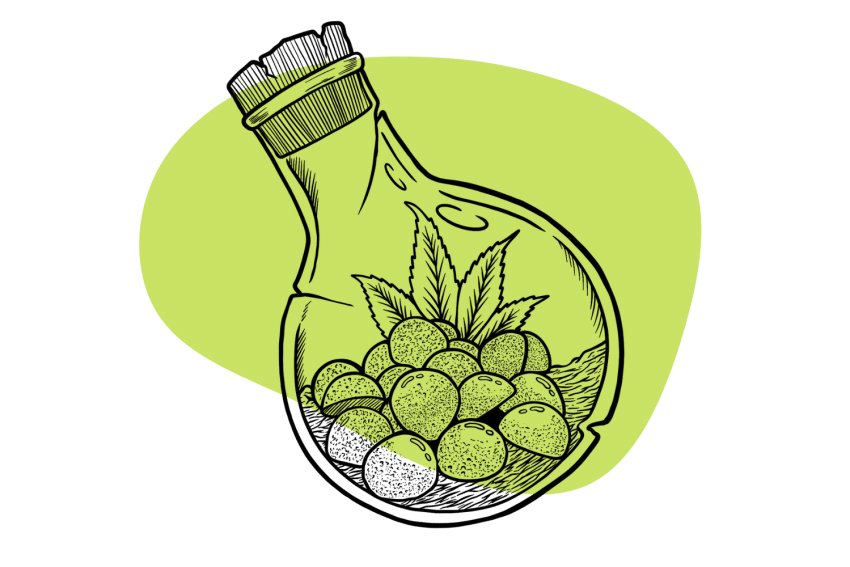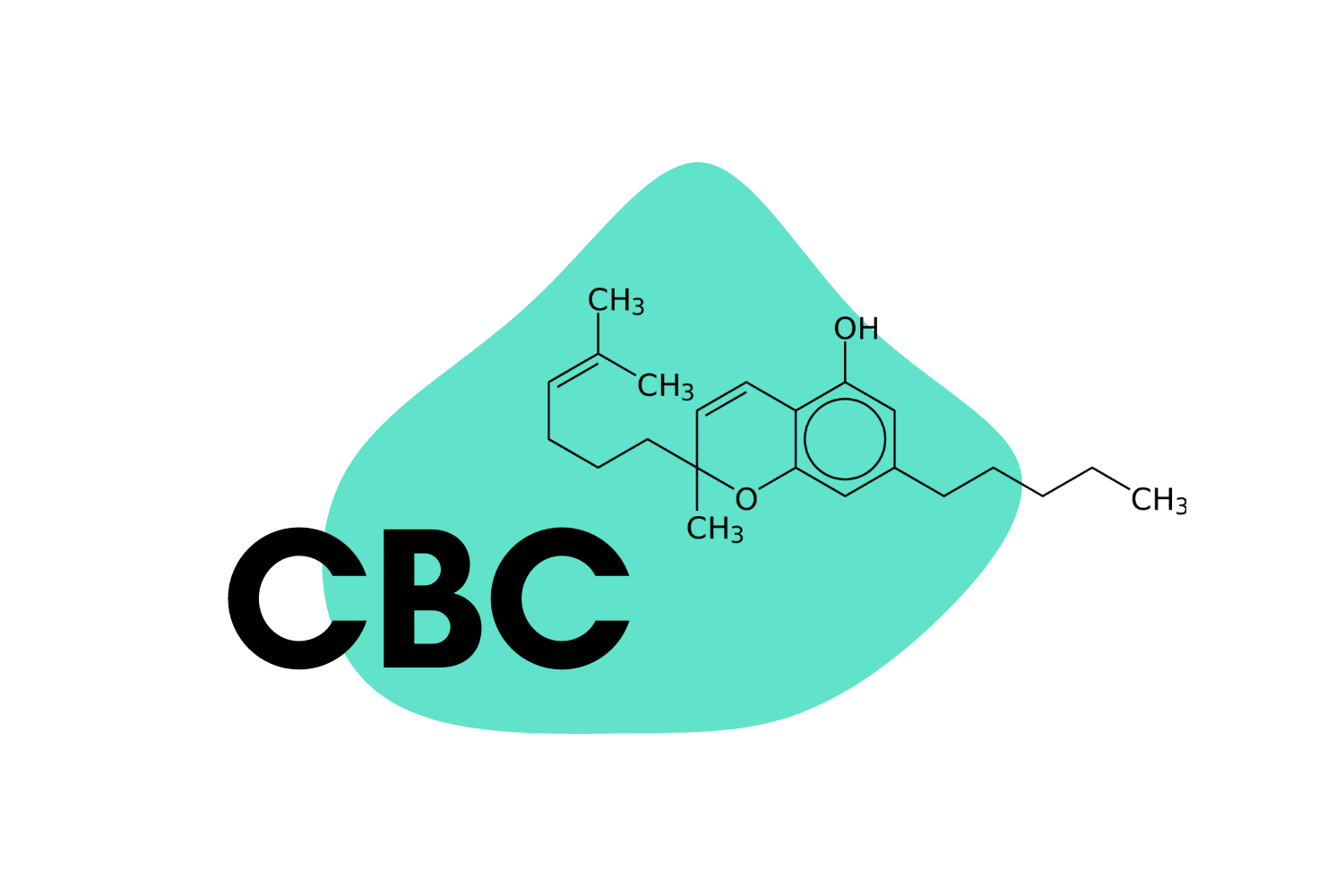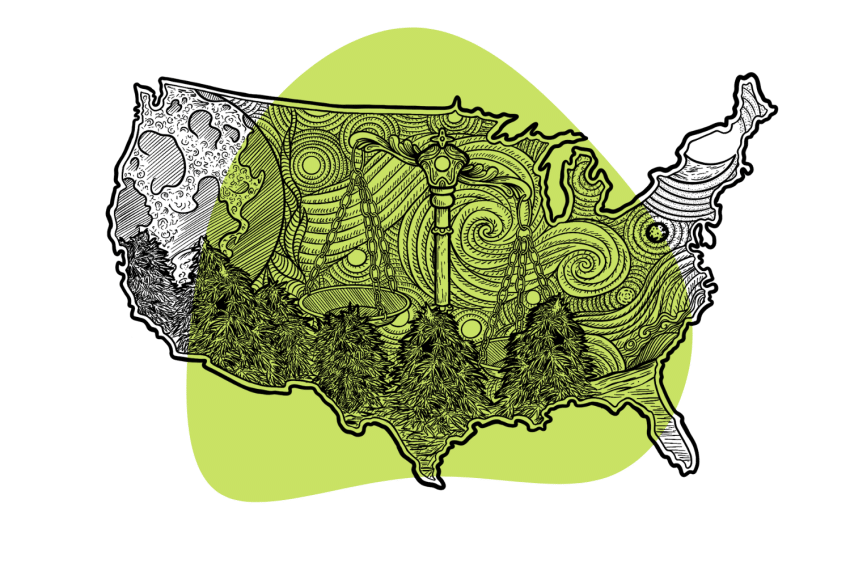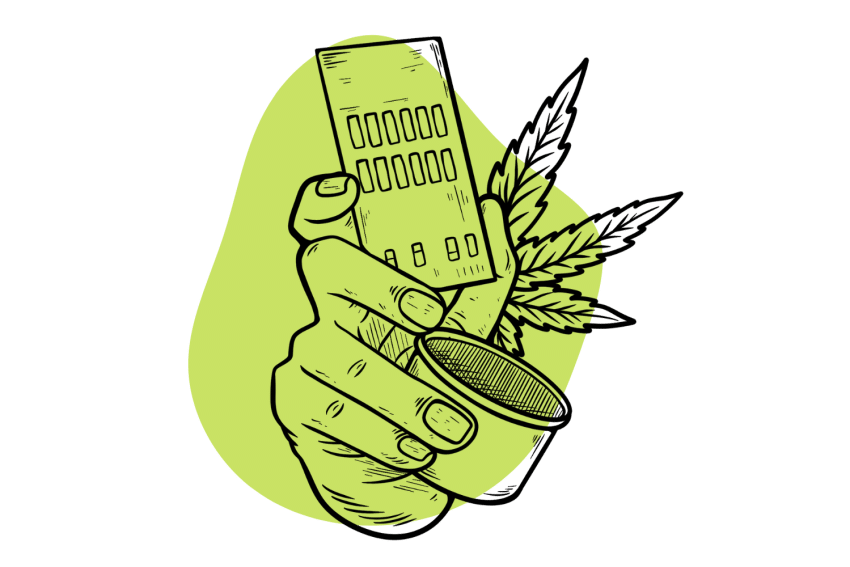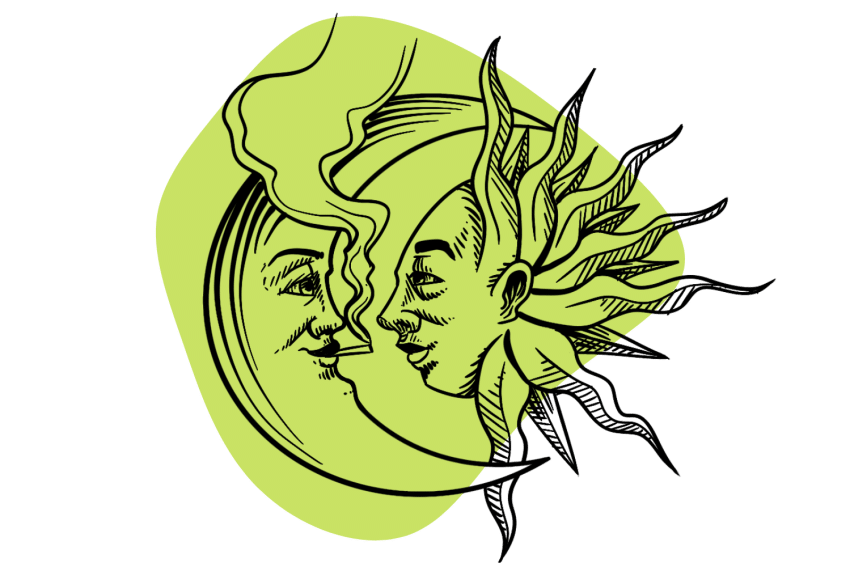THCA Flower Power: Buying Tips, Laws, & Uses
THCA flower, which is nearly identical to marijuana, is legal in many states thanks to a loophole in the law’s definition of “hemp.”
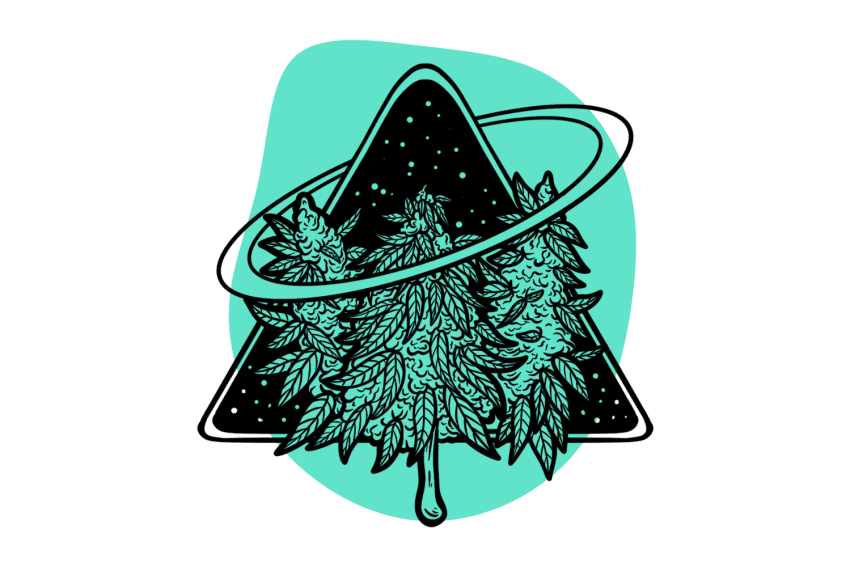
Cannabis sativa is the botanical name for the plant responsible for producing flowers with high cannabidiol (CBD). Also known as “hemp,” these plants are legal throughout the United States and most of the world.
But there’s a problem.
Marijuana — the universally banned and stigmatized plant responsible for producing the psychoactive compound delta-9 tetrahydrocannabinol (THC) — is also a member of the Cannabis sativa species.
Arbitrary laws differentiate each plant depending on the THC concentration of the dried flowers. Anything that produces less than 0.3% THC is hemp; anything above is marijuana.
For years, companies have been extracting trace concentrations of THC from legal hemp to produce psychoactive extracts. Only recently have manufacturers realized that the laws are so specific that some of them actually rule marijuana itself as “hemp.”
Let me explain.
Tetrahydrocannabinolic acid (THCA) is the precursor to THC. It’s the raw form found in abundance in both hemp and marijuana. The loophole here is that the law specifically states “THC” — not “THCA” — which is a different chemical.
In effect, THCA flower is just marijuana flower that’s been harvested early enough to prevent most of the THCA from degrading into the illegal THC.
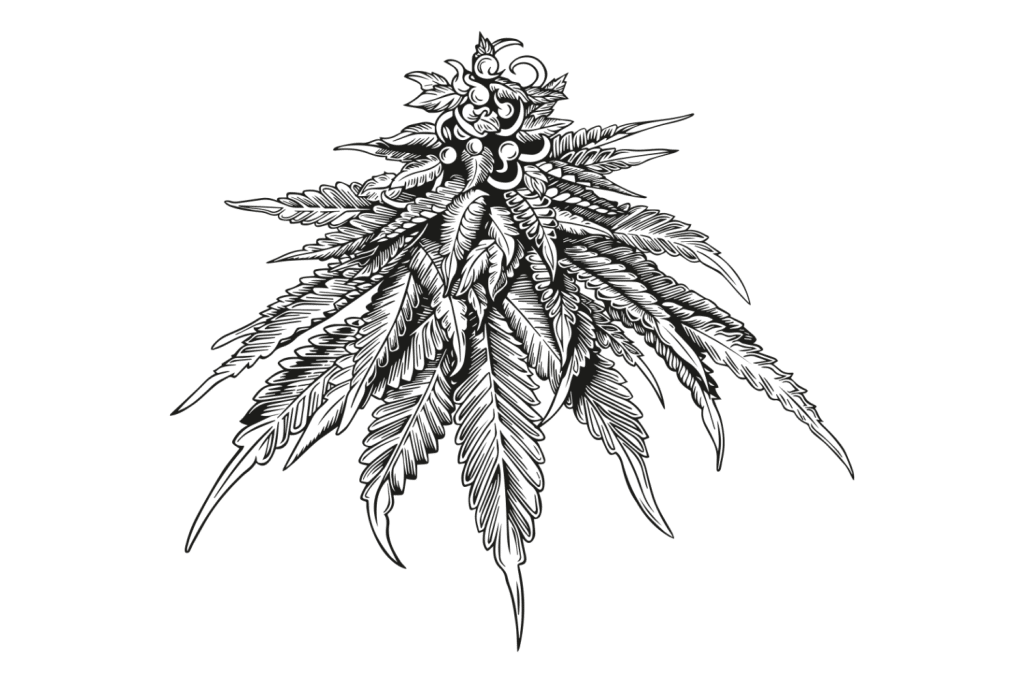
Is There a Difference Between THCA Flower & Weed?
In many ways, THCA flower is indistinguishable from marijuana, where as much as 90% of the total cannabinoid makeup is already THCA [1]. The only difference between the two molecules is a “carboxyl group” — an oxygen molecule double-bonded to a carbon that bonds to a connected oxygen and hydrogen (hydroxyl group).
Over time, heat and oxygen can wear away this bond, resulting in the “decarboxylation” of the molecule into delta-9 THC. Since this change inherently involves losing part of the molecule, the weight of THC from even a lab-controlled conversion is lower than the initial THCA.
In legal dispensaries, the total THC content comes from adding 87.7% of the THCA to the delta-9 THC. This is the percentage of THCA that converts to THC under ideal conditions, which is highly unlikely outside of lab-grade equipment [2].
Some smoking options — like rolling THCA flower into a joint, for example — may convert as little as 30% of the THCA to THC. By listing the full THCA content instead of 87% of it along with THC, some THCA products on the market look stronger than they are.
A 30% THCA flower would show up in markets with recreational marijuana as just 26% THC.
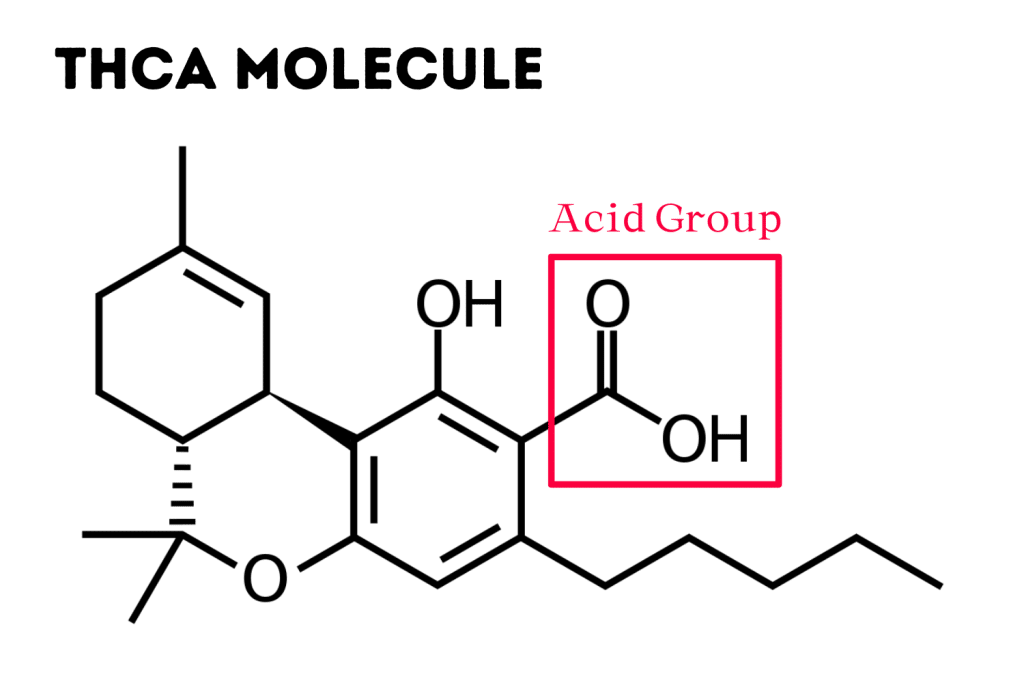
How THCA Is Legal?
Most states without legal marijuana follow the United States Department of Agriculture (USDA) rules from the 2018 Farm Bill. This regulates the production of hemp products, restricting them only to a limit of 0.03% delta-9 THC, opening up a loophole that has led to a surging market of alternative forms of THC.
Delta-8 THC — a natural cannabinoid in minor concentrations that producers synthesize from CBD isolate — was the first to hit the scene. As the popularity of delta-8 took off, delta-10, THCV, and even potent edibles with hemp-derived delta-9 THC started appearing on shelves.
THCA is different because the others were available only in concentrates, vapables, edibles, or sprayed onto hemp flower. THCA grows naturally in cannabis flowers, so producers can grow the same strains in slightly different ways to produce virtually identical products.
Since THCA hasn’t gone through decarboxylation into delta-9 THC, producers claim it exists outside of legislation. It’s not a secret that this is likely the most exploitative use of the Farm Bill loophole, but states have their hands tied without passing legislation to amend the statewide definition of hemp (which some have done).
Within the federal definition, producers only have to test their products for an arbitrary limit of delta-9 THC to meet legal standards. The downside of this is that they don’t have to test for the cannabinoid their product contains (or, at least, claims to contain) in many instances.
As a result, there’s no shortage of sketchy companies, scams, and bad products on the market trying to capitalize on new cannabis trends.
Potential Legal Concerns With THCA Flower
While THCA is technically a legal product, consumers should be aware of the fact that it’s highly likely to be illegal by the time it reaches them and they’re done with it. THCA degrades slowly over time and, while hemp producers have found ways to restrict decarboxylation during growth and packaging phases, stopping it altogether is not possible.
Once the product is in the hands of consumers, the THCA decarboxylates whenever the jar is open, as you’re grinding/storing/transporting it, and more.
As a result, the amount of delta-9 THC could very likely rise to illegal levels in the hands of consumers or even before. One study took samples and put them in ideal conditions (77⁰F with 60% humidity) and found the THC content rose by .8 mg/g after just 3 months [3].
Notably, this study focused on marijuana, which underwent a normal curing process and already had some of its THCA decarboxylate. We don’t know how rapidly THCA would do so in a plant restricted from air and light throughout these processes after suddenly being in normal environments.
The limits for CBD flower and the cannabis legal “hemp” are minuscule and meant to make it very hard to grow effective CBD flower. Difficulties for producers compound exponentially when the point of their crop is a barely legal form of THC.
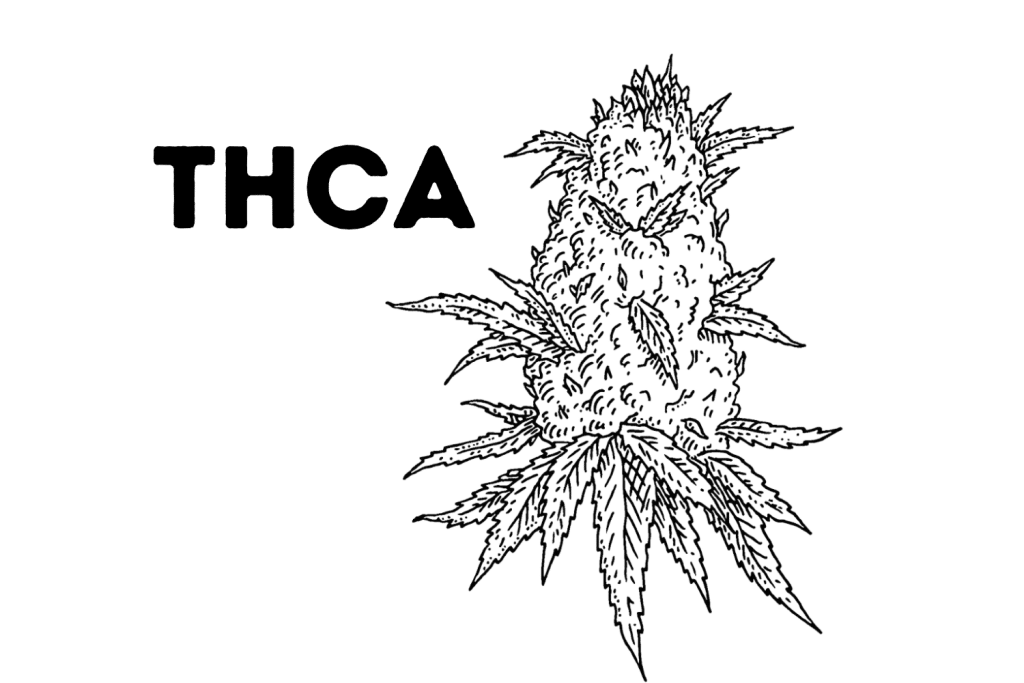
Will THCA Flower Remain Legal?
As the popularity continues to grow for THCA flower and other hemp-derived THC products, some states are taking action to close the legal loophole. In Idaho, for example, no cannabis products can have THC of any kind — federally legal or not.
Other states like Arkansas, Hawaii, Rhode Island, and Utah have medical marijuana programs that lump THCA, delta-8, and all other forms of THC into the .03% limit. This is an effort to keep the newfound cannabinoids in the regulated market but often counteracts the lack of access underpinning their existence in the first place.
Oregon, Minnesota, and Vermont have adult-use programs that include all forms of THC for the same purpose of regulation. Vermont has further decided to ban all “synthetic forms of THC,” prohibiting delta-8, delta-10, and others.
This list is where the fight for prohibition has gotten so far and plenty of other states — like Tennessee — have active efforts to do the same. Some of the concerns surrounding these new THC alternatives have merit to them, as we discuss in other parts of the article.
However, the problematic areas of the hemp market boil down to a lack of oversight and regulation. Born out of a bill that solidifies cannabis prohibition, these problems only exist because there wasn’t an effort to safely provide access to cannabis already.
These products only exist because of criminalization — prohibiting them will only serve to create new, lesser-understood alternatives to fill the gap in demand. If we’re worried about newfangled cannabinoids getting people high, let’s legalize the one we’ve known about and researched since 1964 with millennia of historical use.
Understanding How THCA Forms
Cannabigerol Acid (CBGA) has earned its nickname of the “mother of all cannabinoids” by forming first in the young cannabis plant. Over time, the CBGA transforms into THCAA through the enzyme THCA synthase, or CBDA, through its similarly named enzyme [4].
CBGA itself forms as the result of a series of complex molecular changes:
- Fatty acids within the plant form small chains to create hexanoyl- and malonyl-coenzyme A (HCoA and MCoA), precursor compounds that help make up larger ones
- Tetraketide synthase (TKS), an enzyme responsible for initiating change, combines three molecules from MCoA with HCoA to form 3,5-dioxodecaneoyl-CoA (DCoA)
- Some of the 3,5-DCoA cycles through again to become 3,5,7-trioxododecaneoyl-CoA (TCoA)
- Water in the plant wears down DCoA and TCoA (a process called hydrolysis) into the byproducts pentyl didactic lactone (PDAL) and hexanoyl tiacetic acid lactone (HTAL)
- Through decarboxylation, non-hydrolyzed TCoA sheds its carbon dioxide component (CO2) to form Olivetol.
- Using an enzyme called olivetolic acid cyclase (OAC), this converts to olivetolic acid (OLA), which forms the central component of all cannabinoids.
- Additional enzymes add geranyl pyrophosphate (GPP) to the OLA through an interaction between (DMAPP) and isopentenyl pyrophosphate (IPP)
- Together, GPP and OLA form CBG-A.
The “mother of all cannabinoids” consists of her many ancestor compounds coming together.
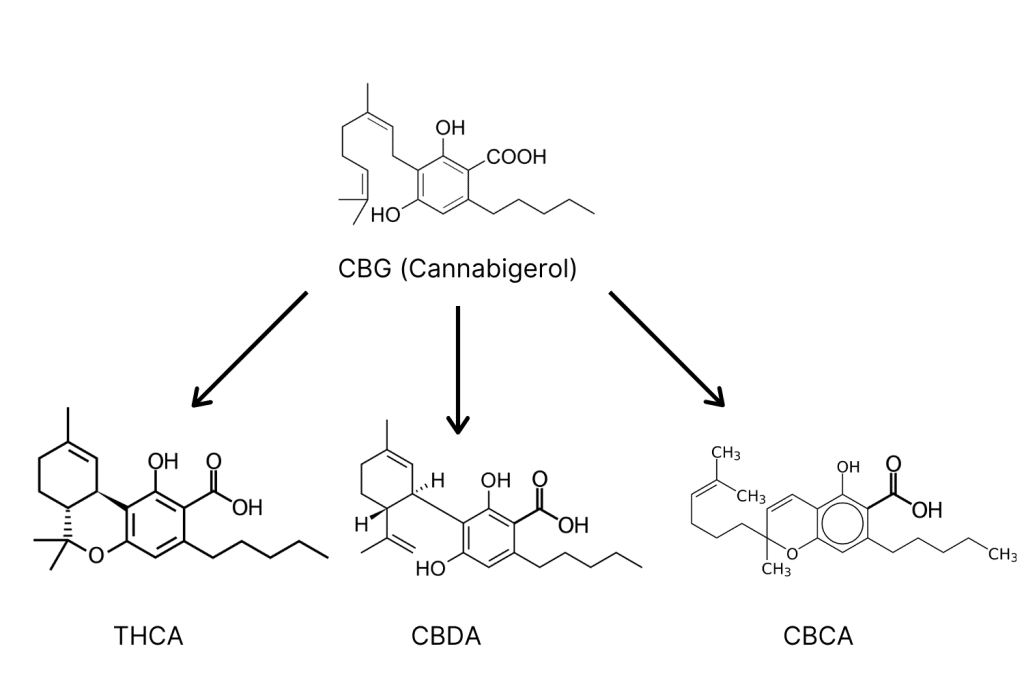
THCA-A Vs. THCA-B
CBGA utilizes synthase reactions and decarboxylation to form the remaining cannabinoids within the plant. Depending on the route it takes and the genetics the plant happens to have encoded within it, these can ultimately form cannabichromenic acid (CBCA), CBDA, or THCA-A/THCA-B [1].
THCA-A can decarboxylate into delta-9 THC, but THCA-B maintains the carboxyl ring in a different position, turning it into cannabinol (CBN) through the same process. CBN — which also forms when delta-9 degrades over time — may help with sleep [5], but it’s rarely the goal of THCA consumers.
In most studies, THCA-B mostly occurs in samples with very small amounts of THCA-A, suggesting it’s a “last-resort” byproduct. However, as one letter to an editor by a researcher pointed out in 2021, THCA-B seems to have an added layer of resiliency — surviving conditions where 90% or more of THCA-A would decarboxylate [6].
THCA-B may form in harsher conditions with high decarboxylation rates as a defense mechanism of sorts, but we don’t know for sure. Make sure to check third-party reports to make sure your THCA provider checks for both and whether they’re adding the two values together.
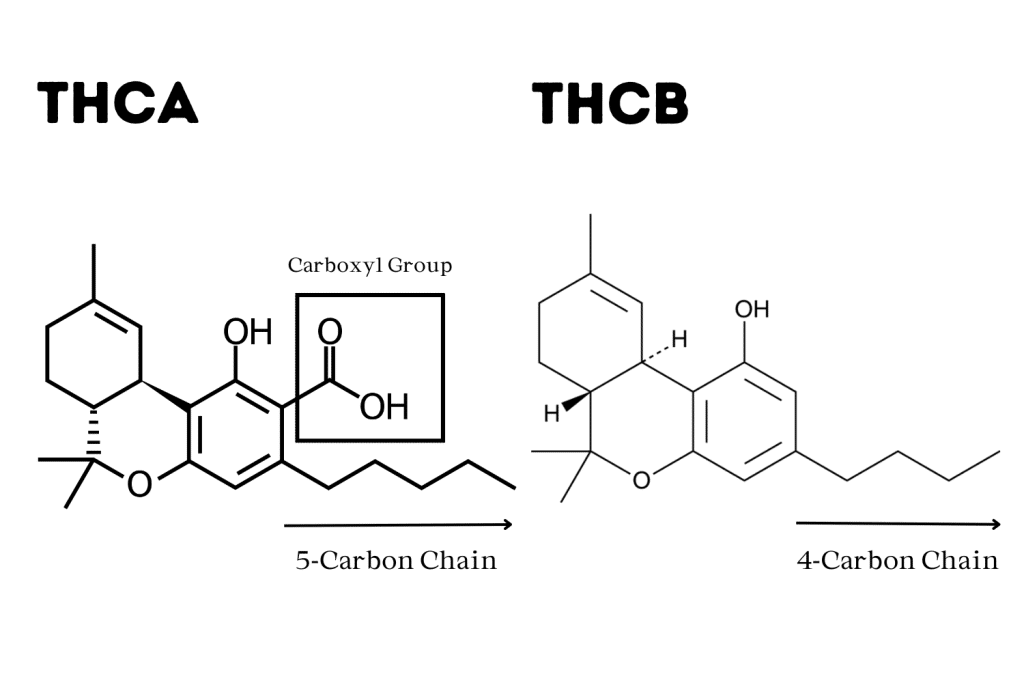
How Does THCA Convert to THC?
There are several potential pathways for THCA to convert into THC, but they all involve decarboxylation through heat and air. In nature, open oxygen and access to sunlight — through heat and, potentially, UV radiation — cause this [7], but a more rapid conversion happens through fire or vaporization.
Degrading the carboxyl ring releases carbon dioxide and removes the acidity of the molecule, dramatically altering its pharmacology.
Luckily for consumers, studies show that shorter durations of higher heat and restricting airflow convert THCA more rapidly. The best tool for this is likely a dry-herb vaporizer capable of reaching high enough temperatures to convert the THCA without reaching extreme temperatures and burning off the THCA or other components in the process.
Outside of a lab setting, however, smoking and vaping are likely to turn more than 30–70% of the THCA into THC (lower with smoking) [2]. THC is a far less stable molecule than THCA and it’s far easier to degrade or destroy it, even at room temperature.
One study found that as much as 10% of the THC content degraded into CBN after 2 months at 77°F [8]. The heat from a flame is so high that it can convert the THCA into THC and then degrade it into CBN before it reaches your lungs.
Vaporizers can rapidly raise temperatures to high levels and quickly decarboxylate the THCA and vaporize the THC without overdoing it. This gives them an advantage over smoking if you’re trying to get the most out of your flower.
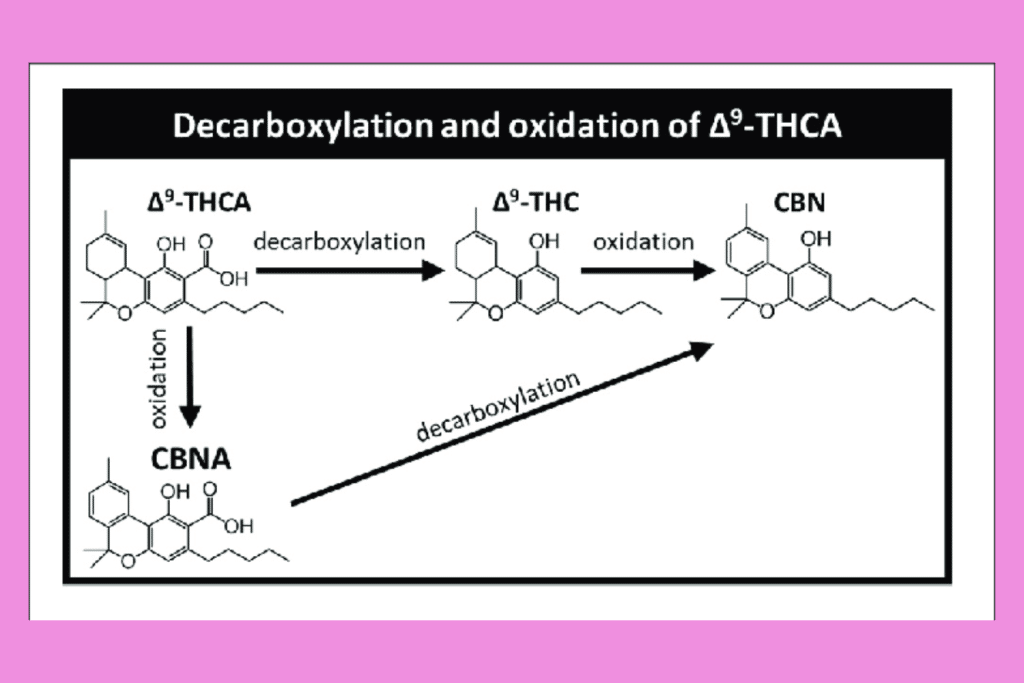
How Is THCA Flower Made?
Since oxygen and sunlight are the main drivers behind THCA converting to the federally illegal delta-9 THC, cultivators have developed techniques to avoid them. By finding ways to grow, cure, and process cannabis flower without heat or air, the precursor cannabinoid can stay locked in.
All marijuana on the market contains a majority of THCA, but producers can reduce the decarboxylation rate to nearly 0%. This keeps them federally legal and a part of the hemp market, devoid of regulation.
How To Find Good THCA Flower
Since the hemp market doesn’t have many regulations to keep it in check, the onus falls on the consumer. When looking for a reputable company from which to purchase THCA, it’s best to see the product in person, if possible, to get a good sense of the quality.
For online and delivery companies, make sure they’re reporting on the contents of their product and have lab reports proving it. Technically, hemp products only have to test for delta-9 THC, and it’s not uncommon for companies to make claims without even reporting on their THCA content.
Look for someone with a lot of reviews, start with a sample purchase before buying bulk, and check out the blog to see how seriously the company takes education. These aren’t set in stone but are all useful ways to find a good vendor.
Avoid companies hinting that they’re selling weed and not THCA flower or refusing to give you a third-party certificate of analysis (CoA). Enough hemp producers are willing to put in the effort to create a great THCA flower and report on it; there’s no need to buy from a shady operation.
Traits of Good THCA Flower
Most people can look at a cannabis bud and instinctively know whether it’s good or bad, but understanding why can help immensely with the choice. Some of it comes down to genetics, but any Cannabis Cup winner could become a dud in the wrong hands, so don’t rely on titles alone.
Appearance, smell, smoke, and flavor all contribute to the evaluation of a particular strain’s weaknesses and strengths.
Appearance:
- Dark or light green with occasional purple hues
- Lots of shiny, sticky trichomes surrounding the flower
- Orange or red hairs throughout (not brown)
- Densely packed buds without leaves or stems surrounding it
- Breaking it apart, you should rarely, if ever, find seeds
Smell:
- Look for a strong aroma indicating the terpenes haven’t evaporated off
- Avoid options with a skunky smell
- Notes of citrus, pepper, diesel, lavender, pine, and hops are common
Smoke:
- The plant should burn without much effort and stay lit, indicating it has the right moisture level
- Avoid quick-burning bud indicating excessive exposure to air and lack of moisture
- The smoke should not have an overbearing effect on the lungs and throat (coughing is normal)
Taste:
- Fruity, peppery, or botanical flavors should accompany the smoke, not rubber or tar.
- Avoid flower that leaves an unpleasant taste in your mouth or burns your throat too much.
The smell and flavor of THCA flower largely come from the terpene content, which is an aromatic essential oil responsible for the strong smell of cannabis. Understanding these is vital for locating the best possible strain for your needs.
Know Your Terpenes
It may seem silly to judge your cannabis flower on the way it smells, but the terpenes contribute greatly to the overall effect of cannabis [9]. They are the reason lavender may help with sleep, peppercorns have a history of helping with headaches, and lemons give a slight uplift to mood and energy.
Here are some of the main terpenes in cannabis (and where else you might find them):
- Linalool — Also common in lavender and mint, this is a big terpene for “cake” and dessert-type strains, helpful for relaxation, easing anxiety, and sleep [9].
- Caryophyllene — Also in peppercorn, this makes up a lot of the “garlic” and some of the “sour” strains out there, helpful for pain and inflammation [10].
- Myrcene — Abundant in mangoes, myrcene has a slightly peppery flavor with a citric kick, helpful for relaxation and sleep [11, 12].
- Pinene — As the name suggests, these are also common in pine needles and abundant in any strain that has a forest aroma to it, helpful for anxiety and mood [13].
- Humulene — You’ve already enjoyed this terpene if you’ve ever drunk beer; it’s a major component of hops and helpful inflammation [14].
- Limonene — The “sativa” terpene, limonene is common in lemon rinds and other citric fruits, helpful for depression and mood [15].
Time degrades terpene content, causing them to aerosolize and create the smell we experience when opening up the stash jar. If your flower doesn’t smell “loud,” it’s missing out on the vital contributions of terpenes and other minor cannabinoids.
It is also a good sign that the product hasn’t gone through proper storage, and your THCA has likely converted over to an illegal amount of THC.
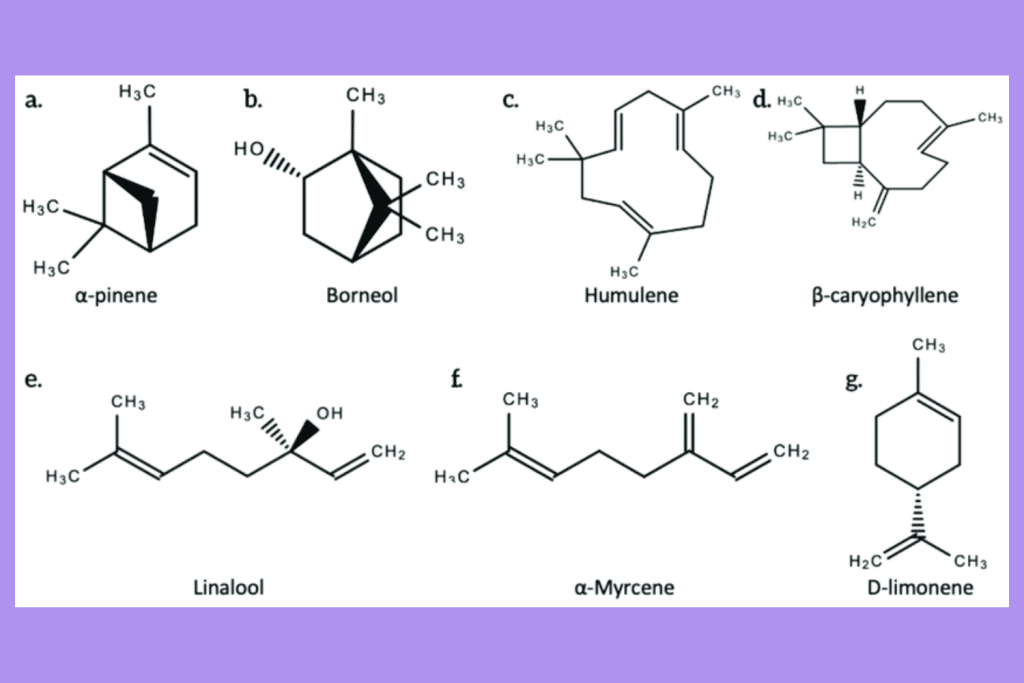
What Can Smoking THCA Flower Help With?
Since THCA is a legal loophole to essentially provide marijuana to restrictive states, it has the potential to help with just about anything THC could assist with. THC primarily interacts with the endocannabinoid system via the CB1 and CB2 receptors throughout the brain and body.
This system acts to maintain “homeostasis” within the body — elevating or lowering various functions to maintain or return to balance.
As a result, it’s shown the potential to be extremely helpful for a lot of conditions, including:
- Pain Management — Especially in moderate doses, THC can help alleviate a variety of pains, but chronic use can lower the threshold users feel pain, making chronic pain more common [16].
- Nausea and Appetite — These two can go hand-in-hand, especially for harsh treatments like chemotherapy, where nausea can prevent patients from consuming enough nutrients [17].
- Central Nervous System (CNS) Diseases — While there is far less research into the issue, studies show THC has the potential to help with multiple sclerosis, epilepsy, Parkinson’s, Huntington’s, and other degenerative diseases.
- Mood, Behavior, and Sleep — Anxiety, sleep, post-traumatic stress disorder (PTSD), compulsive drug seeking, and others can all potentially benefit from moderate amounts of THC [18].
- Cancer and Cellular Degradation — Still early on in research, but glaucoma (degeneration of retinal cells) and cancer (uncontrollable growth of dangerous cells) both seem to respond well to THC.
Importantly, cannabis usually works better in moderation than excessive use. As tolerance to THC begins to build, effective doses can elevate to high levels and ultimately make cannabis less effective overall.
Like the system it interacts with, the key is balance.
FAQs: THCA Flower
Here are some of the most common questions people ask about THCA flower:
1. Can You Eat Raw THCA Flower?
THCA has several potential health benefits, but don’t expect it to make you feel loopy or high. While THCA is promising for helping ease nausea and other similar benefits, it doesn’t activate the endocannabinoid receptors in the same way as its non-acidic sibling.
A lot of people enjoy adding fresh cannabis to smoothies, teas, or dishes without heating them to the point of decarboxylation. The benefits aren’t as recreational, but they certainly aren’t absent.
2. Is Smoking THCA Flower Bad for Your Lungs?
Yes — there is no plant on this planet that you can burn, inhale its smoke, and not cause some level of damage to your lungs. However, there is no current link between any form of lung cancer and smoking marijuana [19].
Exposing the lungs to smoke over long periods can weaken them and make them less effective at fighting off disease. As a result, chronic marijuana smokers may become more vulnerable to bronchitis, pneumonia, and other respiratory diseases.
3. Can You Get Second-Hand High From THCA Flower?
While the potential for getting high off second-hand cannabis smoke is minuscule, it’s possible. The risk increases exponentially when, along with the amount of cannabis a person smokes, the ventilation (or lack thereof), and the cleanliness of the home since THC can also settle onto flooring and dust particles [20].
In the case of smoking joints, the side stream of smoke coming off the lit end between puffs contains far more THC than the exhaled smoke from a water pipe or similar. The lungs absorb much of the THC, but small amounts do still exist in the exhaled breath.
Don’t smoke around children, pets, or adults who don’t want to be around it — be respectful and step into the other room or outside.
4. What’s the Difference Between Smoking and Vaping THCA Flower?
While most people consume their cannabis flower by smoking it, using a dry herb vaporizer could be a more efficient method. Studies looking into the conversion of THCA to THC through combustion have found it to have a far lower conversion rate than vaporization.
One study simulating smoking a joint — likely the lowest conversion method there is due to it burning between puffs — found the conversion rate may be as low as 30% [2]. With a dry-herb vaporizer, you can compactly pack the chamber to prevent airflow, heat it to the point of vaporizing the THCA, and keep it there without the plant material catching on fire.
5. How Long After Smoking THCA Will You Fail A Drug Test?
THCA follows the same metabolic process as THC, so it will show up similarly on drug tests. For occasional smokers, THC metabolites typically exit through the urinary system within 3—5 days.
However, frequent users may fail drug tests for a month or even longer after they quit consuming THCA. It’s best to play it safe and not take the risk if there’s a chance that you’ll have to submit to drug testing.
References
- Moreno-Sanz, G. (2016). Can You Pass the Acid Test? Critical Review and Novel Therapeutic Perspectives of Δ9-Tetrahydrocannabinolic Acid A. Cannabis and Cannabinoid Research, 1(1), 124–130. https://doi.org/10.1089/can.2016.0008
- Dussy, F. E., Hamberg, C., Luginbühl, M., Schwerzmann, T., & Briellmann, T. A. (2005). Isolation of Delta9-THCA-A from hemp and analytical aspects concerning the determination of Delta9-THC in cannabis products. Forensic Science International, 149(1), 3–10. https://doi.org/10.1016/j.forsciint.2004.05.015
- Gigopulu, O., Geskovski, N., Stefkov, G., & Makreski, P. (2022). THCA → THC conversion and its importance for the stability and quality of the herbal material. Macedonian Pharmaceutical Bulletin, 68, 111–112. https://doi.org/10.33320/maced.pharm.bull.2022.68.04.049
- Tahir, M. N., Shahbazi, F., Rondeau-Gagné, S., & Trant, J. F. (2021). The biosynthesis of the cannabinoids. Journal of Cannabis Research, 3, 7. https://doi.org/10.1186/s42238-021-00062-4
- Lavender, I., McCartney, D., Marshall, N., et al. (2023). Cannabinol (CBN; 30 and 300 mg) effects on sleep and next-day function in insomnia disorder (‘CUPID’ study): Protocol for a randomized, double-blind, placebo-controlled, cross-over, three-arm, proof-of-concept trial. BMJ Open, 13(8), e071148. https://doi.org/10.1136/bmjopen-2022-071148
- Filer, C. N. (2021). Letter to the Editor: On the Reluctant Decarboxylation of THCA-B. Cannabis and Cannabinoid Research, 6(5), 446–448. https://doi.org/10.1089/can.2021.0003
- Filer, C. N. (2022). Acidic Cannabinoid Decarboxylation. Cannabis and Cannabinoid Research, 7(3), 262–273. https://doi.org/10.1089/can.2021.0072
- Repka, M. A., Munjal, M., ElSohly, M. A., & Ross, S. A. (2006). Temperature Stability and Bioadhesive Properties of Δ9-Tetrahydrocannabinol Incorporated Hydroxypropylcellulose Polymer Matrix Systems. Drug Development and Industrial Pharmacy, 32(1), 21–32. https://doi.org/10.1080/03639040500387914
- Russo, E. B. (2011). Taming THC: Potential cannabis synergy and phytocannabinoid-terpenoid entourage effects. British Journal of Pharmacology, 163(7), 1344–1364. https://doi.org/10.1111/j.1476-5381.2011.01238.x
- Linck, V. M., da Silva, A. L., Figueiró, M., Caramão, E. B., Moreno, P. R. H., & Elisabetsky, E. (2010). Effects of inhaled Linalool in anxiety, social interaction and aggressive behavior in mice. Phytomedicine, 17(8), 679–683. https://doi.org/10.1016/j.phymed.2009.10.002
- Nutrients | Free Full-Text | Protective Effects of (E)-β-Caryophyllene (BCP) in Chronic Inflammation. (n.d.). Retrieved March 8, 2024, from https://www.mdpi.com/2072-6643/12/11/3273
- Gurgel do Vale, T., Couto Furtado, E., Santos, J. G., & Viana, G. S. B. (2002). Central effects of citral, myrcene, and limonene, constituents of essential oil chemotypes from Lippia alba (Mill.) N.E. Brown. Phytomedicine, 9(8), 709–714. https://doi.org/10.1078/094471102321621304
- Salehi, B., Upadhyay, S., Erdogan Orhan, I., Kumar Jugran, A., L. D. Jayaweera, S., A. Dias, D., Sharopov, F., Taheri, Y., Martins, N., Baghalpour, N., C. Cho, W., & Sharifi-Rad, J. (2019). Therapeutic Potential of α- and β-Pinene: A Miracle Gift of Nature. Biomolecules, 9(11), Article 11. https://doi.org/10.3390/biom9110738
- Fernandes, E. S., Passos, G. F., Medeiros, R., da Cunha, F. M., Ferreira, J., Campos, M. M., Pianowski, L. F., & Calixto, J. B. (2007). Anti-inflammatory effects of compounds alpha-humulene and (−)-trans-caryophyllene isolated from the essential oil of Cordia verbenacea. European Journal of Pharmacology, 569(3), 228–236. https://doi.org/10.1016/j.ejphar.2007.04.059
- Antidepressant-like Effect of Citrus sinensis (L.) Osbeck Essential Oil and Its Main Component Limonene on Mice | Journal of Agricultural and Food Chemistry. (n.d.). Retrieved March 8, 2024, from https://pubs.acs.org/doi/abs/10.1021/acs.jafc.9b00650
- Richardson, J. D. (2000). Cannabinoids modulate pain by multiple mechanisms of action. The Journal of Pain, 1(1), 2–14. https://doi.org/10.1016/S1526-5900(00)90082-8
- Kirkham, T. C., & Williams, C. M. (2001). Endogenous cannabinoids and appetite. Nutrition Research Reviews, 14(1), 65–86. N., Suraev, A., Irwin, C., D’Rozario, A. L., Gordon, C. J., Saini, B., Grunstein, R. R., Yee, B., McGregor, I., & Hoy https://doi.org/10.1079/NRR200118
- Legare, C. A., Raup-Konsavage, W. M., & Vrana, K. E. (2022). Therapeutic Potential of Cannabis, Cannabidiol, and Cannabinoid-Based Pharmaceuticals. Pharmacology, 107(3–4), 131–149. https://doi.org/10.1159/000521683
- Tashkin, D. P. (2018). Marijuana and Lung Disease. Chest, 154(3), 653–663. https://doi.org/10.1016/j.chest.2018.05.005
- Askari, A., Wania, F., & H. Chan, A. W. (2023). Modeling the fate and involuntary exposure to tetrahydrocannabinol emitted from indoor cannabis smoking. Environmental Science: Atmospheres, 3(4), 760–772. https://doi.org/10.1039/D2EA00155A

